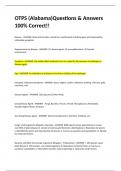OTPS (Alabama)Questions & Answers
100% Correct!!
Disease - ANSWER Abnormal function caused by a continuously irritating agent and expressed by
noticeable symptoms
Requirements for disease - ANSWER (1) disease agent; (2) susceptible plant; (3) favorite
environment
Symptom - ANSWER The visible effect produced in or on a plant by the presence of pathogen or
disease agent
Sign - ANSWER An indication of a disease from direct visibility of the pathogen
Examples of Disease Symptoms - ANSWER Spots, blights, cankers, diebacks, stunting, chlorosis, galls,
root-knot, wilt.
Disease Agents - ANSWER (1)Living and (2) Non-living
Living Disease Agent - ANSWER : Fungi, Bacteria, Viruses, Viroids, Mycoplasmas, Nematodes,
Parasitic Higher Plants, Protozoa
Non-living Disease Agent - ANSWER Environmental factors, Nutrition, Pollution, etc.
Fungi: small organisms (Kingdom Mycetae) - ANSWER 8000 species cause plant disease ii. Cause
over 80% of plant disease iii. Consist of microscopic filaments called hyphae iv. Reproduce by spores
v. Identified by spores and reproductive structures vi. Survive as parasites and saprophytes vii. Spread
by wind/rain/insects
Bacteria: primitive microscopic organisms (Kingdom - Prokaryotes) - ANSWER i. 200 species cause
plant disease ii. Microscopic, one-celled organisms iii. Reproduce by binary fission iv. Survive as
parasites/ saprophytes v. Infect plant wounds/ natural openings vi. Spread by wind/ insects
, Viruses: submicroscopic structures - ANSWER i. 500 + cause plant disease ii. Submicroscopic
organisms iii. Obligate parasites iv. Nucleic acid and protein coat v. Replicate within the host cell vi.
Infect plants through wounds vii. Spread by insect/seed/animals
Nematodes: small round worms (Kingdom - Animal) - ANSWER i. Round worms - plant parasites are
microscopic ii. Need live host to survive iii. Use stylet to feed on plant cells iv. Most plant nematodes
feed on roots v. 4 Juvenile stages and adult form and over-winter egg stage vi. Generation time 30
days (1-5 generations/yr.) vii. Spread by soil transport
Disease Control Principles - ANSWER i. Exclusion ii. Eradication iii. Protection iv. Resistance
Disease Control Practices/Methods - ANSWER i. Cultural: modifications in planting, soil fertilization,
irrigation, soil preparation, etc. ii. Chemical: most are protective sprays; some chemicals provide
eradication iii. Genetic: plant resistant varieties or cultivars iv. Biological
Field Diagnosis Observe Plants carefully - ANSWER 1. Check foliage for spots, yellowing, mosaics,
marginal burns, growth abnormalities, insect damage 2. Examine stems and crowns for internal
discoloration, external discoloration, fungal structures, bacterial ooze. 3. Examine roots for
discoloration, swelling, stunting, absence of secondary roots
Field Diagnosis Considerations - ANSWER recent weather, chemicals/fertilizers applied, soil
conditions, insect problems, animal damage disease, nematodes, patterns of the damage
Collecting/ Packages Mailing Samples Collecting - ANSWER 1. If spots, collect affected plant parts 2.
If poor growth, collect whole plants 3. Include development stages of the problem 4. Include damage
but not dead plants 5. If large plants, collect 1-3 6. If small plants, collect several - many 7. Collect
and record and include information
Collecting/ Packages Mailing Samples Packaging - ANSWER 1. Gently shake soil from roots 2. Package
plants in dry plastic 3. May need to wrap root ball separately 4. Packaging loose soil separately 5.
Package fruits/crucifiers in newspaper
Collecting/ Packages Mailing Samples Mailings - ANSWER 1. Use a sturdy padded envelope or box 2.
Mail early in week 3. Address properly The Plant Diagnostic Lab 101 Extension Hall Auburn
University, AL 36849-5624
Laboratory Diagnosis Activities of the Plant Diagnosis Lab - ANSWER 1. Plant problem/disease-
diagnosis 2. Soil nematode analysis 3. Insect Identification 4. Weed/plant identification




